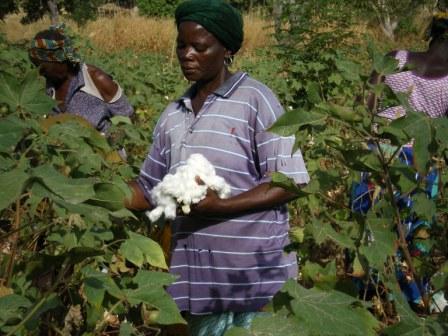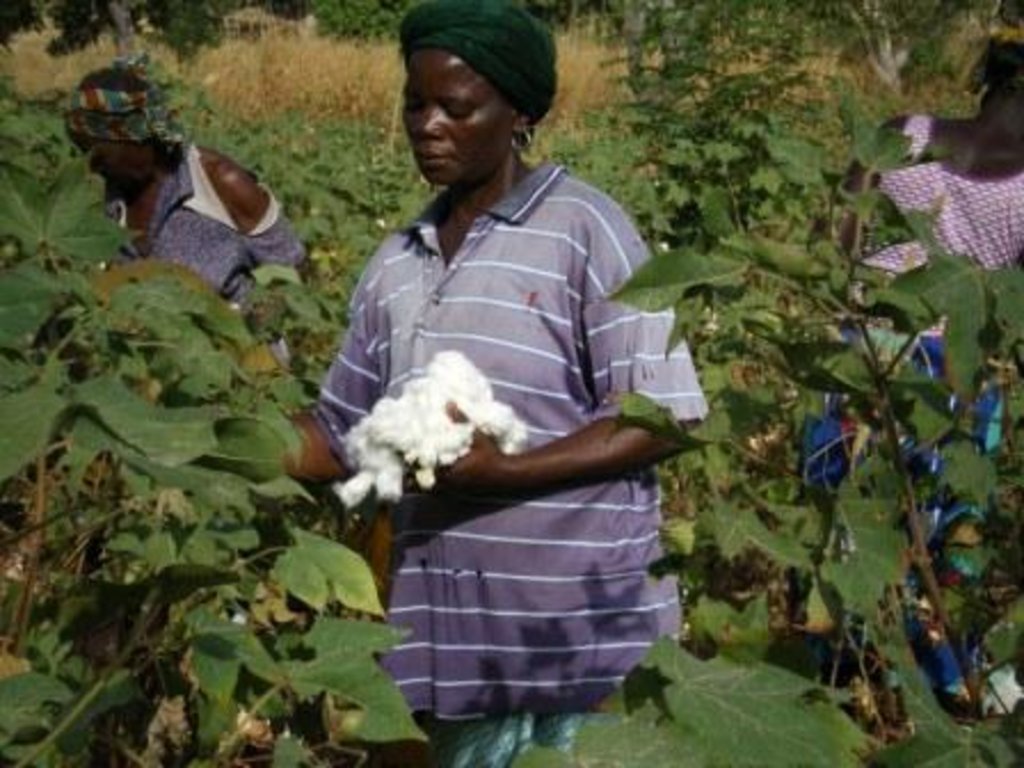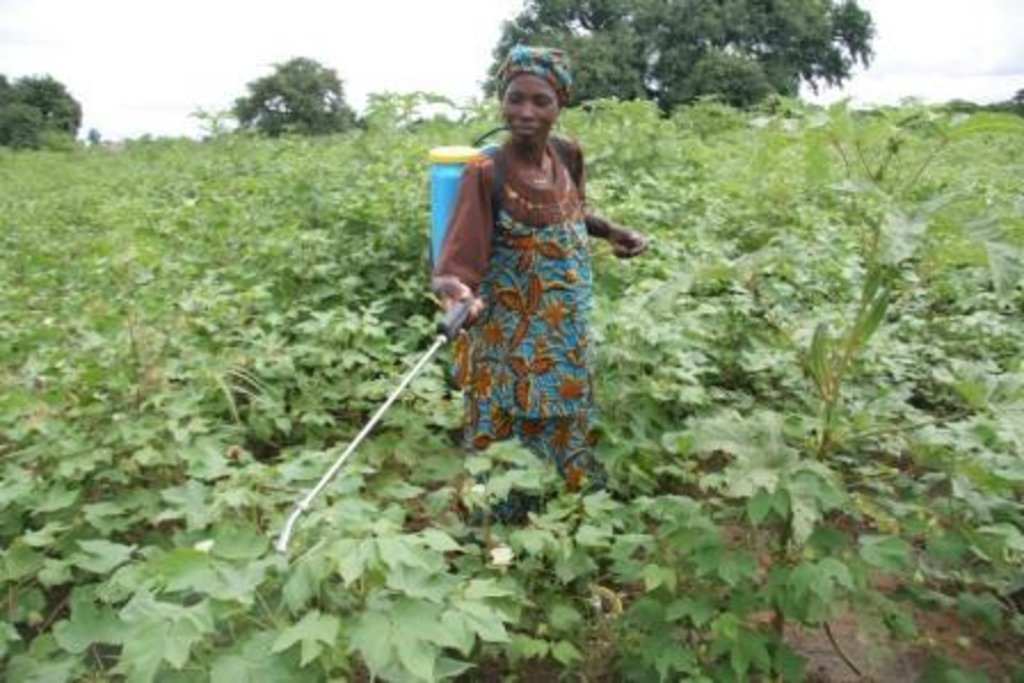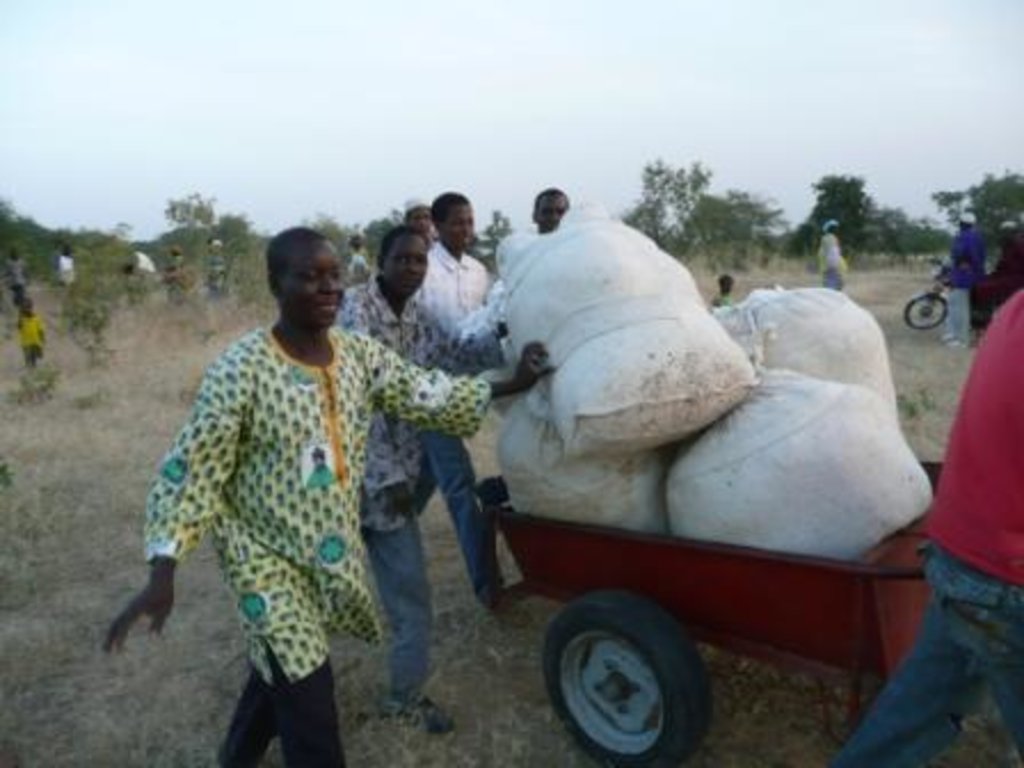Organic cotton [بوركينا فاسو]
- تاريخ الإنشاء:
- تحديث:
- جامع المعلومات: Julie Zähringer
- المحرر: –
- المُراجع: Alexandra Gavilano
technologies_957 - بوركينا فاسو
عرض الأقسام
توسيع الكل طي الكل1. معلومات عامة
1.3 الشروط المتعلقة باستخدام البيانات الموثقة من خلال WOCAT
يوافق جامع المعلومات والشخص (لاشخاص) الرئيسي لمصدر المعلومات على الشروط المتعلقة باستخدام البيانات الموثقة من خلال WOCAT:
نعم
2. وصف تقنيةالإدارة المستدامي للأراضي
2.1 وصف مختصر للتقنية
تعريف التقنية:
In the Loba province of Burkina Faso, the production, storage, processing and marketing of organic cotton has been promoted since 2004 by Helvetas.
2.2 وصف تفصيلي للتقنية
الوصف:
Organic cotton production adheres to the principles and standards of organic farming. Any application of synthetic fertilizers and pesticides and the use of genetically modified varieties are forbidden. Organic cotton relies on a combination of different measures: (1) the use of organic fertilizers (manure or compost) and recycling of organic matter; (2) Crop rotation and/or intercropping; (3) Careful selection of varieties adapted to local conditions (climate, soil, pests and diseases); (4) Biological pest management (in combination with careful monitoring of crops); (5) Clear separation of organic and conventional cropland, e.g. by growing border crops (to avoid contact with chemical substances through spray drift or surface runoff); and (6) Soil and water conservation measures. Timely crop management (e.g. weeding) is very important. In Loba rotations crops include sesame (a cash crop), cereals and legumes (food crops), while intercrops include leguminous green manure and trap plants. The best adapted cotton variety is FK-37. Bio-pesticides are produced based on neem seeds (Azadirachta indica). The measures listed above help to improve soil fertility, reduce production costs (and thus financial risk) and avoid the negative effects of conventional farming: declining yields, resistance to pests and diseases, health hazards and environmental problems caused through the use of chemicals. By relying on inputs available/produced on the farm and by getting a better price for certified organic products, profitability of the farm is improved in the long run despite of lower productivity compared to conventional or genetically modified (GM) cotton. Farms need to complete a 3-year conversion period to change their production system from conventional to organic. Farmers have to maintain records and documents for periodic inspection and certification (Internal control system).
2.3 صور التقنية
2.5 البلد/المنطقة/المواقع التي تم تنفيذ التقنية فيها والتي يغطيها هذا التقييم
البلد:
بوركينا فاسو
المنطقة/الولاية/المحافظة:
Ioba province
مزيد من التفاصيل حول الموقع:
Dano
2.6 تاريخ التنفيذ
في حالة عدم معرفة السنة بالتحديد، يرجى الإشارة إلى التاريخ التقريبي:
- منذ أقل من 10 سنوات (مؤخرًا)
2.7 إدخال التقنية
حدد كيف تم إدخال التقنية:
- من خلال المشاريع/ التدخلات الخارجية
3. تصنيف تقنية الإدارة المستدامي للأراضي
3.2 نوع (أنواع) استخدام الأراضي الحالية حيث يتم تطبيق التقنية

الأراضي الزراعية
- زراعة معمرة (غير خشبية)
التعليقات:
Major land use problems (land users’ perception): Fertility decline and reduced OM content; Biodiversity decline
3.3 مزيد من المعلومات حول استخدام الأراضي
إمدادات المياه للأرض التي يتم تنفيذ التقنية عليها:
- بعلية
3.5 انتشار التقنية
التعليقات:
around 7'000 farmers
3.6 التدابير التقنية في مجال إلادارة المستدامة للأراضي

التدابير الزراعية
- A2: المادة العضوية/خصوبة التربة
التعليقات:
Main measures: agronomic measures
Type of agronomic measures: mixed cropping / intercropping, legume inter-planting, manure / compost / residues
3.7 الأنواع الرئيسية من تدهور الأراضي التي تناولتها التقنية

التدهور الكيميائي للتربة
- (Cn): تراجع الخصوبة وانخفاض محتوى المادة العضوية (غير ناتج عن الانجراف)

التدهور البيولوجي
- (Bs): انخفاض جودة وتركيبة الأنواع/التنوع
التعليقات:
Main type of degradation addressed: Cn: fertility decline and reduced organic matter content, Bs: quality and species composition /diversity decline
3.8 منع أو حد أو عكس تدهور الأراضي
تحديد هدف التقنية فيما يتعلق بتدهور الأراضي:
- الحد من تدهور الأراضي
- منع تدهور الأراضي
التعليقات:
Main goals: prevention of land degradation, mitigation / reduction of land degradation
4. المواصفات الفنية، وأنشطة التنفيذ، والمدخلات، والتكاليف
4.2 المواصفات الفنية/شروحات الرسم الفني
Technical knowledge required for field staff / advisors: high
Technical knowledge required for land users: moderate
Main technical functions: improvement of ground cover, increase in organic matter, increase in nutrient availability (supply, recycling,…), promotion of vegetation species and varieties (quality, eg palatable fodder)
Secondary technical functions: improvement of water quality, buffering / filtering water
Mixed cropping / intercropping
Material/ species: intercrops include leguminous green manure and trap plants
Manure / compost / residues
Material/ species: manure or compost
Agronomic measure: bio-pesticides
Material/ species: from Neem seeds (Azadirachta indica)
4.6 الصيانة/الأنشطة المتكررة
| النشاط | نوع التدبير | التوقيت/الوتيرة | |
|---|---|---|---|
| 1. | Compost production / Clear crop residues on fields where cotton will be planted, use for mulch or compost production (no burning) | زراعية | |
| 2. | Apply organic manure: 7.5 t/ha / Ploughing (for incorporation of manure, pest and weed control) | زراعية | |
| 3. | Sow cotton and intercrops (such as Hibiscus esculentus – a trap plant for pests; or Mucuna – a green manure plant); Thin out cotton after 10-20 days (1-2 plants per pocket) | زراعية | |
| 4. | Weeding (3 to 4 times: 20/40/70/100days after sowing) / Pest control (manual collection); Spraying of bio-pesticide (64 liters / ha, based on neem seeds): according to infestation: up to 3 times | زراعية | |
| 5. | Ridging (form furrows and ridges using plough or manually) / Pre-harvest weeding / Harvesting / Cut cotton stems / residues and incorporate into the soil | زراعية |
4.7 التكاليف والمدخلات اللازمة للصيانة/للأنشطة المتكررة (سنويًا)
التعليقات:
Machinery/ tools: hoe, plough, wheel-barrow, knapsack
4.8 أهم العوامل المؤثرة على التكاليف
قدم وصفا لأهم العوامل التي تؤثر على التكاليف:
Standard equipment (hoe, plough, wheel-barrow) is not included in costs, knapsack is provided by producer’s association (UNPCB) on credit; transport bags are donated. Labour and other inputs for erosion control measures (e.g. stone bunds) are not included in costs. Neem biocide costs US$ 0.7 per liter; organic cotton seeds cost US$ 1.7 per 50 kg.
5. البيئة الطبيعية والبشرية
5.1 المناخ
هطول الأمطار السنوي
- < 250 مم
- 251- 500 ملم
- 501 - 750ملم
- 1,000-751 ملم
- 1,500-1,100 ملم
- 2,000-1,500 ملم
- 3,000-2,001 ملم
- 4,000-3,100 ملم
- > 4000 ملم
المنطقة المناخية الزراعية
- شبه قاحلة
Thermal climate class: tropics. tropical, with high rainfall variability
5.2 طوبوغرافيا
متوسط الانحدارات:
- مسطح (0-2%)
- بسيط (3-5%)
- معتدل (6-10%)
- متدحرج (11-15%)
- تلال (16-30%)
- شديدة الانحدار(31-60%)
- فائقة الانحدار (>60%)
التضاريس:
- هضاب/سهول
- أثلام مرتفعة
- المنحدرات الجبلية
- منحدرات التلال
- منحدرات في السفوح
- قاع الوادي
المنطقة الارتفاعية:
- 100-0 متر فوق سطح البحر
- 500-101 متر فوق سطح البحر
- 1,000-501 متر فوق سطح البحر
- 1,500-1,001 متر فوق سطح البحر
- 2,000-1,501 متر فوق سطح البحر
- 2,500-2,100 متر فوق سطح البحر
- 3,000-2,501 متر فوق سطح البحر
- 4,000-3,001 متر فوق سطح البحر
- > 4000 متر فوق سطح البحر
5.3 التربة
متوسط عمق التربة:
- ضحل جدًا (0-20 سم)
- ضحلة (21-50 سم)
- متوسطة العمق (51-80 سم)
- عميقة (81-120 سم)
- عميقة جدًا (> 120 سم)
قوام التربة (التربة السطحية):
- ناعم/ثقيل (طيني)
- خشن / خفيف (رملي)
المواد العضوية في التربة السطحية:
- متوسطة (1-3%)
5.6 خصائص مستخدمي الأراضي الذين يطبقون التقنية
التوجه السوقي لنظام الإنتاج:
- مختلط (كفاف/ تجاري)
أفراداً أو مجموعات:
- فرد/أسرة معيشية
مستوى المكننة:
- عمل يدوي
- الجر الحيواني
اذكر الخصائص الأخرى ذات الصلة لمستخدمي الأراضي:
Difference in the involvement of women and men: certain activities carried out in mutual help groups
Population density: 50-100 persons/km2
5.7 متوسط مساحة الأرض المملوكة أو المستأجرة من قبل مستخدمي الأراضي الذين يطبقون التقنية
- < 0.5 هكتارا
- 0.5 - 1 هكتار
- 1 -2 هكتار
- 2 - 5 هكتار
- 5 - 15 هكتار
- 15 - 50 هكتار
- 50 - 100هكتار
- 500-100 هكتار
- 1,000-500 هكتار
- 10,000-1,000 هكتار
- > 10,000 هكتار
هل يعتبر هذا نطاقًا صغيرًا أو متوسطًا أو واسعا (في إشارة إلى السياق المحلي)؟:
- على نطاق صغير
5.8 ملكية الأراضي، وحقوق استخدام الأراضي، وحقوق استخدام المياه
ملكية الارض:
- دولة
حقوق استخدام الأراضي:
- فردي
التعليقات:
group (family clans) / state
6. الآثار والتصريحات الختامية
6.1 الآثار التي أظهرتها التقنية في الموقع
الآثار الاجتماعية والاقتصادية
الدخل والتكاليف
دخل المزرعة
الآثار الاجتماعية والثقافية
الوضع الصحي
الآثار الايكولوجية
التربة
دورة المغذيات/إعادة الشحن
المادة العضوية في التربة/تحت الطبقة c
التنوع البيولوجي: الغطاء النباتي، الحيوانات
الأنواع المفيدة
6.3 تعرض التقنية وحساسيتها لتغير المناخ التدريجي والظواهر المتطرفة/الكوارث المرتبطة بالمناخ (كما يراها مستخدمو الأراضي)
التعليقات:
Tolerant to climatic extremes due to higher water retention capacity of soils, reduced erosion and crop diversification (reduced risk of total crop failure)
6.4 تحليل التكلفة والعائد
كيف يمكن مقارنة العوائد نسبة لتكاليف الإنشاء (من وجهة نظر مستخدمي الأراضي)؟
عوائد قصيرة الأجل:
سلبي
عوائد طويلة الأجل:
إيجابي قليلا
كيف تتم مقارنة العوائدمع كلفة الصيانة/التكاليف المتكررة (من وجهة نظر مستخدمي الأراضي)؟
عوائد قصيرة الأجل:
إيجابي
عوائد طويلة الأجل:
ايجابي جدا
التعليقات:
Establishment costs are higher than revenues due to investments & initial decrease in yield (conversion period). On the long term, advanced farmers can achieve same or even higher yields than conventional cotton systems
6.5 اعتماد التقنية
التعليقات:
100% of land user families have adopted the Technology with external material support
Comments on adoption trend: The proportion of organic cotton is growing
6.7 نقاط القوة / المزايا / الفرص التي توفرها التقنية
| نقاط القوة/ المزايا/ الفرص من وجهة نظر جامع المعلومات أو غيره من الاشخاص الرئيسيين لمصدر المعلومات |
|---|
| This technology helps to improve soil fertility, reduce production costs (and thus financial risk) and avoid the negative effects of conventional farming: declining yields, resistance to pests and diseases, health hazards and environmental problems caused through the use of chemicals |
6.8 نقاط ضعف / مساوىء / مخاطر التقنية وسبل التغلب عليها
| نقاط الضعف/ المساوىء/ المخاطر من وجهة نظر مستخدم الأراضي | كيف يمكن التغلب عليها؟ |
|---|---|
| Lack of water | establish water retention structures |
| نقاط الضعف/ المساوىء/ المخاطر من وجهة نظر جامع المعلومات أو غيره من الاشخاص الرئيسيين لمصدر المعلومات | كيف يمكن التغلب عليها؟ |
|---|---|
| Coexistence of organic and GMO cotton resulting in high risk of contamination | intensify training of farmers; set up a coordination platform between organic and GMO farms; GMO communication plan; establish a sampling & testing system |
| Insufficient application of manure / compost | training on compost production; promote supply of organic manure (e.g. through SMEs specialized in compost production). |
| Large distance to cotton fields (resulting in high transportation costs) due to interfering of browsing livestock close to village | hay-making and corralling of livestock. |
| Lack of land, land ownership and land security | promote land leasing; resolve tenure problem on political level. |
| Lack of equipment (e.g. plough) | Develop and maintain access to credits for small-scale farmers. |
7. المراجع والروابط
7.2 المراجع للمنشورات المتاحة
العنوان، المؤلف، السنة، النظام القياسي الدولي لترقيم الكتب ISBN:
Helvetas. 2008. Guide de production - Un manuel de reference (Authors: Ouedraogo A, Yombi L, Doumbia S, Eyhorn F, Dischl R)
العنوان، المؤلف، السنة، النظام القياسي الدولي لترقيم الكتب ISBN:
Eyhorn F., S.G. Ratter, M. Ramakrishnan. 2005. Organic Cotton Crop Guide – A Manual for Practitioners in the Tropics; Research Institute of Organic Agriculture FiBL, Frick, Switzerland
الروابط والوحدات المواضيعية
توسيع الكل طي الكلالروابط
لا يوجد روابط
الوحدات المواضيعية
لا يوجد وحدات مواضيعية







